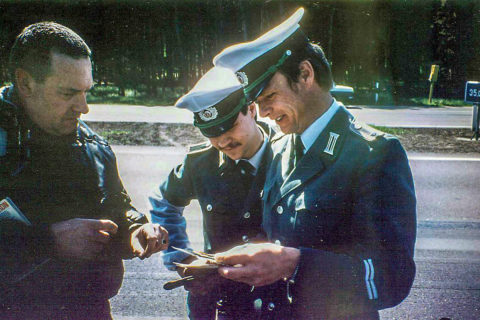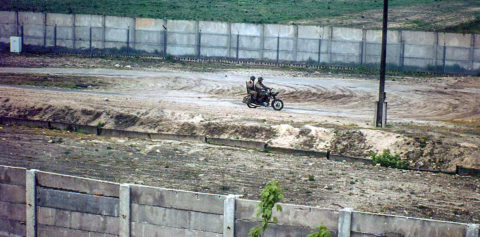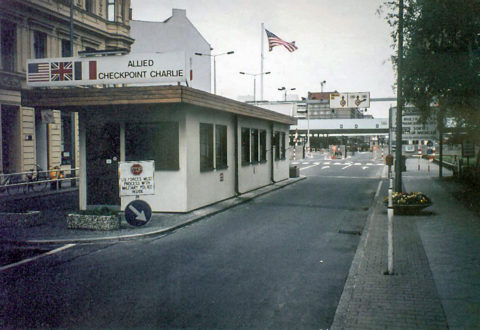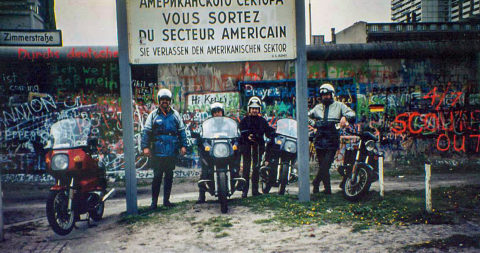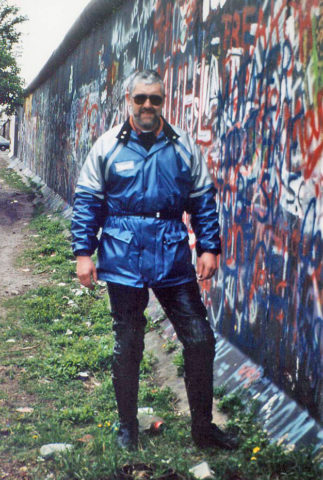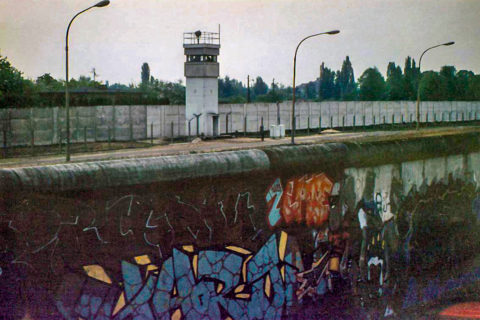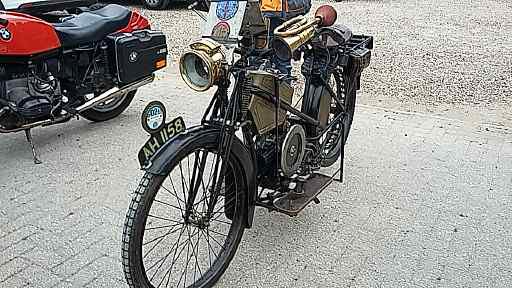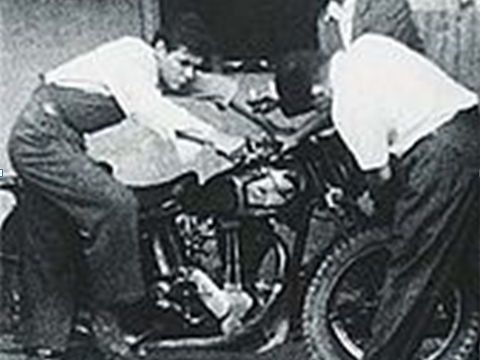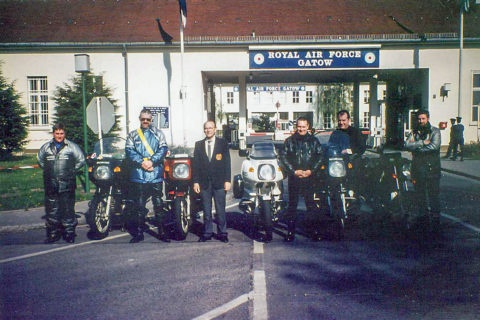
Through the Iron Curtain on Two Wheels from Roger Newark.
In 1989, some other BMW riders that I knew asked if I would like to join them on a ride to the BMW factory in Berlin to see how our machines were built. As it happened, the day jobs for these other four riders (Ken, Jim, Dave and Maurice) were that they were all traffic policemen in the Metropolitan Police in London, and wanted to ride their own personal machines to Berlin. 25 years earlier I had also been a London copper for a couple of years, until a career change came along. Additionally, they were members of the International Police Association (IPA), which is a body which assists police officers travelling to other countries on holiday etc, and so the IPA arranged for our hosts to be the West Berlin Kriminalpolizei (CID). The West Berlin Police didn’t actually have any accommodation that they could offer us, so they arranged for us to be co-hosted by both the RAF Police and the Royal Military Police based in West Berlin.
And so one day in May 1989, the five of us rode our bikes down to Dover and caught the ferry across to Ostend, where we rode across Belgium and found accommodation for the night on the Dutch border. The following day we carried on with our journey across West Germany until we reached the border crossing point at the East German border at Helmstedt.
This crossing point was known to the Allies as Checkpoint Alpha and was quite a formidable sight. From the West German side we could look across no man’s land to the East German border guards in their watchtowers studying us with binoculars. We showed our passports to the West German border officials and rode into no man’s land towards the East German control point, where we had to submit our passports to a grim faced, non- smiling East German border guard, who passed the passports through a small hatch behind him, where, we understood, they were photocopied. We then rode a further hundred metres to a another control booth where we collected our passports again, the documents having been passed along a small covered tunnel with a conveyor belt inside that moved the passports from one control room to the other. However, before we could actually enter East Germany, or the DDR (Deutschland Democratic Republic), we had to purchase 25 Deutschmarks worth of amount of East German Marks (Ostmark), at a 1:1 exchange rate, which was worthless outside the DDR, and you weren’t allowed to bring any out either. I did, and still have them!
We were now in Communist East Germany and had to ride a further 100 kilometres to West Berlin (the city of Berlin then being a virtual island within Communist East Germany, and which was further subdivided into the Western (US, British and French) zones, and the Eastern (Russian) zone). The sterile corridor that we had to ride along was, in reality, a rather badly maintained two lane autobahn, which we were not allowed to deviate from. Eventually we reached the outskirts of West Berlin, where we passed once again through the East German border control at Checkpoint Bravo, and presented ourselves to the West Berlin authorities and in particular to the British Military Police office, who were expecting us. There we met our RAF police escort, who we followed across West Berlin to our accommodation at RAF Gatow, where we were given rooms in the Sergeant’s Mess.
Over the next four days we met our West Berlin Police contact, Heinrich. He arranged for us to visit the Berlin Police Marine Division, who patrolled the River Spree, with the East/West border running down the middle of the river at one point. The Royal Military Police gave us an excellent curry lunch, curries being a British Army speciality, and this one really was superb. A Squadron Leader from the RAF Police took us around the highlights of West Berlin, then a showcase of capitalist consumerism, presumably for the benefit of their Communist neighbours on the other side of the Berlin Wall.
We made our planned visit to the BMW factory at Spandau, near the site of the infamous Spandau prison where Rudolf Hess spent his remaining years, although he had died a couple of years earlier. The prison had been demolished and the rubble buried secretly to foil the neo-Nazi brigade.
The BMW visit was fascinating to us petrol heads, but the odd thing was, although the factory were expecting us, and gave us an interesting guided tour, we were not even offered a cup of coffee during the whole time there! One thing we did see were the Press test fleet of the (then new) K1 model, ready for its world debut.
But without a doubt, my most memorable day was the one where we rode our bikes through Checkpoint Charlie and into East Berlin. Immediately we were aware of the drabness of the East, with many buildings still showing the battle scars from the end of World War 2, when the Russian Army captured the city. Shops had a very limited range of State produced items displayed in their windows, and everywhere the little Trabant cars chugged about, emitting two stroke smoke into the air. The showpiece street of East Berlin was the Unter den Linden, where we parked our bikes opposite the “Neue Watch”, a building that housed the Memorial to the Victims of Fascism and Militarism, with a very smart DDR soldier at attention outside the entrance.
As we locked our bikes to cross the road, an East German civilian came up to us and said, in heavily accented English, “there is no need to lock your motorcycles, you are in East Germany. We have no crime”. We thanked him for his concern, and was only later I realised that for an East German to approach and speak to western visitors in such an open and high profile location, could only have meant that he was a member of the Stasi, the East German secret police.
The day came to start our homeward ride, back down the 100 km transit corridor. We had only been riding a few kilometres, when we were waved down by two East German “Peoples Police” (Volks Polizei or VoPo), who were standing at the side of the road with their Russian built Lada patrol car. The reason for the stop was that our lead rider, Dave, didn’t have his headlight switched on. When that was sorted out, we got the message across to them that they were talking to British coppers, whereupon Maurice produced a pack of photos of London police cars and showed them to the two VoPos. The sight of Range Rovers and the like in police service produced disparaging remarks (in German) and looks from them about the Ladas they had to drive. Maurice had also brought with him a variety of police memorabilia, such as miniature truncheons, lapel badges etc. He tried to give some to the two VoPos, and it was obvious from their faces that they would have loved to accept, but who could trust who within the society that that they lived in? So the gifts remained unaccepted.
What we didn’t know on that May trip in 1989, was the momentous events of the following November when the Berlin Wall was to come down. Four years ago my wife Jackie and I drove to Berlin, and visited many of the places that I saw on the earlier trip. One of those was the crossing point at Helmstedt (Checkpoint Alpha), which has been preserved exactly as it was, as a memorial to those troubled years.

